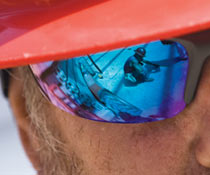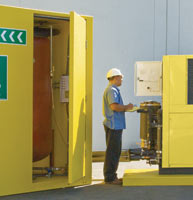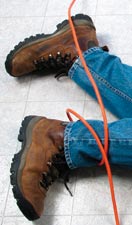
September 2007
- Protecting the Invisible Employee
- Seven Steps to Safety Incentive Success
- Nanotechnology: Progress, New Guidance
- The Art of Reverse Tempering
Click here to subscribe.
Cover Story

By Linda J. Sherrard
A disgruntled field employee (in front of a crew of scowling, arms-crossed guys) tossed a set of dirty, beat-up safety glasses at me in disgust. "They're scratched, this no good piece of #@*!" he exclaimed. The explanation: A piece of debris or gravel had been slung while on a maintenance job, deeply scratching the lens.
Features
By Jay Swearingen, Jeremy Carter
IGNORANCE is never bliss when it comes to the safety clothing you should be wearing. In fact, ignorance is no longer an excuse accepted by employers for workers not wearing the proper gear. Organizations such as OSHA impose a variety of safety requirements, and some insurance companies compel certain shops to publish minimum safety requirements in full view of the workers.
By Tony Titus
A recent USA Today list of the 25 Top Medical Events of the past 25 years listed "The rise of the AED" at number 9: "Hundreds and perhaps thousands of cardiac arrest victims are saved each year by folks using an AED, which delivers a shock to a dying heart. The first models were sold for home use in 1986, but it was in the early 1990s when the device became so simplified with voice prompts that even children could use one to save a life." (Big Dose of Medical Change, July 16, 2007)

By Bill Smith
IN the world of gas detection, one fact stands out above all else: Gas monitors are made to protect and preserve your life. And while serving as a life-saving device, they can be considered a multi-purpose tool in many other ways, as well. For example, they can be used to monitor a confined space prior to entry to ensure the area is safe for anyone entering the space.
By Michelle M. Smith
COMPANIES all over the world are being challenged to do more with less, gain a competitive advantage by maximizing the effectiveness of their employees, and boost productivity in their operations--none of which is an easy task to accomplish. Although there's no silver bullet to magically attain these noble goals, there is a proven methodology for achieving just that in your safety incentive programs.

By Casey Hayes
GLOBAL economic growth—spurred by the popularity of outsourcing manufactured goods—continues its unprecedented rise. During this period, it’s interesting to note that much of the offshore industrial windfall is focused within warmer, often downright hot, climates. Geographically warm areas in Asia are struggling to keep pace with a mushrooming demand for lower-cost parts, components, and finished products.
By Stephanie A. Dean
In a place where temperatures can reach 125 degrees and heavy forklift traffic is a constant, safety is bound to be an extreme challenge. With 80 employees in an aluminum smelting facility, achieving any significant safety milestone may seem like a far-fetched concept.

By Marc Barrera
NANOTECHNOLOGY safety regulations may be years away. Many have suggested OSHA can use existing standards and the General Duty Clause to regulate safe nanotechnology practices, but the latter requires having some guidance on exposure limits and best practices from EPA or non-regulatory organizations.

By Barry R. Weissman
THIS is part of my continuing series of useful links from the Internet. In this month’s edition, we look at Summer Safety. Underground Cables and Electricity In the summer, we may be doing some home remodeling to ensure that we have curb appeal. This means we have to dig up the ground around the home. Before we can do that, we have to get a utility markout by calling at least three days before we start work.

By Donald R. Groover, CIH, CSP
IN the first installment of this series, we discussed the foundation of the injury-free culture, creating alignment around what we mean by “zero injury,” and establishing true ownership for this vision. Once we have created alignment and ownership, what’s next? How does this new vision change our approach to, and thinking about, the basic mechanisms that drive safety performance?
Departments
By Jerry Laws
OSHA, the International Safety Equipment Association, the National Rifle Association, and roughly 2,000 shooting enthusiasts seemed eager to stop two standards initiatives in mid-July, giving me the odd feeling that what I saw as a lethargic but sensible approach to rulemaking was revolutionary to others. It's a matter of perspective.
By Robert Pater
WHAT can you do when you've "tried everything" technically, yet still have stubborn problems? Try a strategic leadership approach.
As I See It
By Linda J. Sherrard
Thoughts from OH&S Technical Editor Linda J. Sherrard, MS, CSP
By Kevin A. Kirschner
I have worked in the field of vision care for more than 34 years. The number one visual complaint over most of those years has been the headaches and eyestrain caused by fluorescent lighting. Somewhere along the line, someone said, "If a little bit of light is good, then a lot of light must be great!" Nothing could be further from the truth. Making the visual system work harder to compensate for the glare is never smarter.